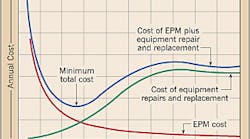One question people often ask is, How much maintenance is needed? There are as many answers to this question as there are facilities. One of the issues to consider is how much are you willing to pay? If you had an unlimited budget and all the resources you could use, everything would be in like-new condition and unscheduled outages would be almost non-existent. However, that isn’t how companies are run, so there are limits to what you can do.
Just as there are as many answers to that question as there are facilities, there are also just as many opinions as to which answer is right. Over the years the electric utilities have set the pace for most maintenance intervals because they owned the majority of equipment and had a lot of expertise on staff. However, in the past they had large O&M budgets and their primary focus was to ensure reliability to keep the Public Utilities Commission off their backs. This has changed with the evolving utility deregulation markets. They are being forced to behave like industrials, where reliability may not be the primary focus, but yet must still be balanced against cost in order to stay competitive.
The study, which was conducted years ago, found that if maintenance programs are planned out properly and performed at the correct intervals, a preventive maintenance (PM) program can save a company as much as $5 for every dollar invested. The problem is this money comes from losses that don’t occur; breakdowns, overtime, loss of production and purchasing replacement equipment at premium prices. It often isn’t an item that can be pointed out to the accounting department.
Photo 1 shows what’s left of a medium-voltage air breaker that failed to clear a fault (restrike). The apparatus quickly cascaded into total meltdown.
Oftentimes a facility with poor maintenance brings in a new manager who proceeds to set up a good PM program. He gets promoted and leaves and the facility brings in another new manager who has no history to work from. He sees the costs involved with the PM program, reduces it greatly or eliminates it, saving the facility a good deal of money. Things roll along happily for a few years and he gets promoted. The new guy comes in and things start to get bad again. Either he gets fired for being incompetent, gets transferred or, worse yet, a committee is appointed. A new manager is brought in to start a PM program and get things settled out again. That manager eventually gets promoted and the cycle renews itself.
The best process is to develop a PM program that works and follow it, even though it may seem unnecessary at times. The difficult part is determining what will work and what is too much. Our goal should always be to achieve the maximum benefit at the minimum cost.
Choosing a PM Tool Set. When looking for tools to assist in developing an effective maintenance program, take advantage of the help available to you. Predictive maintenance (PdM) has been buzzing around for years. PdM is diagnostics performed with the equipment online whereas PM is performed with the equipment offline. The goal of PdM is to allow the equipment to run as long as possible and schedule an outage just before it dies to prevent the problem.
Infrared thermography is one such PdM tool. Thermal imaging cameras scan electrical connections and equipment to find variations in the temperature that can indicate unbalanced loads, loose connections, low oil levels, or overloading. For this to be effective, you’ll need a qualified technician who is not only certified, but also has enough field experience to be able to know what is or isn’t proper.
The technology behind thermography has changed tremendously over the last few years, so having newer equipment is a big plus. Often the instruments take a video or photograph of the component at the same time the infrared image is also taken, which is helpful in locating the actual problem. The main benefit of this technology is the ability to locate a problem before it takes you offline. And best of all, you can do this without having to de-energize the system.
However, this technology does have its shortcomings. It’s limited in what it can detect. It can only uncover hot electrical connections or other sources of high/abnormal heat. Another shortcoming is that the equipment must be in service and under load for many defects to be evident. This means taking covers off switchgear and MCCs and surveying them while energized. This means that whoever performs the scans must wear proper flash protective equipment suitable for the hazard. Many infrared technicians don’t wear it because of the cost and discomfort.
Online monitoring systems are another PdM option. They can be configured to monitor nearly any parameter of your electrical power equipment on a continuous basis to provide round-the-clock coverage. The main drawback of this technology, of course, are the costs of installing the system and maintaining it.
On the PM side, the NFPA has issued standard number 70B, “Recommended Practice for Electrical Equipment Maintenance.” This is a consensus standard reviewed and revised every three years. It has general maintenance recommendations for many types of electrical devices, including power system equipment. If your facility has no maintenance program in place, the 70B standard will provide the direction needed to start one, virtually from scratch.
NETA also provides some guidance for preventative maintenance. Standard MTS-01, “Maintenance Testing Specifications,” covers details on what tests and maintenance are required, and what the recommended values are for evaluation. It also includes a section on how often maintenance should be performed. A portion of the standard that applies to maintenance intervals is reproduced in Table 1.
Although the directions for using the matrix in MTS-01 list some of the criteria needed to consider, it only lists some of the primary issues. The following list is a more complete.
- Location of the equipment
. Is it indoors or outside in the weather? If it’s outside, is it located near or on structures that could affect its performance such as cement plants, chemical plants, coastal waterways, or cooling towers? Equipment located in a clean, controlled environment with positive pressure and good HVAC will require less maintenance than equipment located on an open mezzanine that vibrates constantly and fills up with dirt.
- Service/loading
. How heavily loaded is the equipment? Lightly loaded equipment requires far less maintenance than equipment that’s heavily loaded.
- Duty cycle
. How often do protective devices operate? Circuit breakers and switches that operate frequently, and especially those that operate due to faults or overloads, will require more frequent servicing.
- Fault service
. Again, devices that open faults at or near their rated interrupting capacity are going to suffer more damage than those that don’t. A short-circuit analysis will determine the level of fault current available at various points throughout your system.
- Type of equipment
. Reactors, capacitors, and similar pieces of equipment place a greater demand on switching devices than do less reactive loads.
- Nuisance tripping
. How expensive is it if you have nuisance trips? How often can you have them before it really hurts?
- Load criticality
. If the equipment dies an untimely death, how much will it cost or how much damage will occur?
- Backup
. If the equipment fails, do you have a backup?
- Cost
. Is this an expensive piece of equipment or is it an off-the-shelf item?
- Availability
. Is it off-the-shelf or something that is manufactured when it is ordered? Some power transformers can take as many as two years to deliver. Can you wait that long for a replacement?
- Technical staff
. How competent are they? Do they attend training on a regular basis to maintain their skill/knowledge level? Do you encourage them to receive training or do you see it as throwing good money after bad?
- Contractors
. If you use contractors for all or part of your maintenance, how qualified are they? Is it always lowest cost or do you factor in best value items, such as experience, knowledge level, certifications, age and condition of test equipment, and reputation?
- Test equipment
. Was it new at the turn of the century? Is it calibrated? Does it have adequate capabilities to give you the information you need?
Using The Frequency Matrix. Using Table 1 and Table 2, which is the inspection and test frequency table from Appendix B, NETA MTS-01, assume you have a small dry-type transformer that feeds a critical load and is in poor condition. According to the matrix, the multiplier would be 0.25. Table 2 supplies the maintenance frequency, in months. In this example, you would reference Section 7.2.1.1, which recommends a visual, mechanical, and electrical inspection and maintenance at 36-month intervals. Multiplying the 36 months by 0.25 would provide a recommended interval of 9 months. This would have to be modified based on your experience with the unit and the factors given above, but if it’s in poor condition and the load was truly critical, you should probably consider replacement in the near future, also.
Note that Table 2 is laid out by Section number. Section 7.2 focuses on transformers, section 7.3 focuses on cables, and section 7.4 is for switches. These sections are contained in the body of the specifications and are where the maintenance, testing, and evaluation recommendations are contained.
Copies of NETA’s MTS-01 and their Acceptance Testing Specifications (ATS-99) are available from any NETA-member company or from NETA itself.
As power systems age and people rotate in and out of various supervisory and management positions, the electrical power systems they manage become more and more at risk. Money saved by shortcutting maintenance is false savings. One additional factor to consider in the mix is that of personnel safety. A properly coordinated and maintained system is not only more reliable, but safer to operate as well. Exposing personnel or your power system to this tremendous force for any extended time period is not only destructive, but can be fatal.
Proper maintenance costs money, but the payback is a savings over a longer period of time, a reduction in unscheduled outages, and much fewer headaches.
White is director of training for Shermco Industries, Inc., Irving, Texas.



